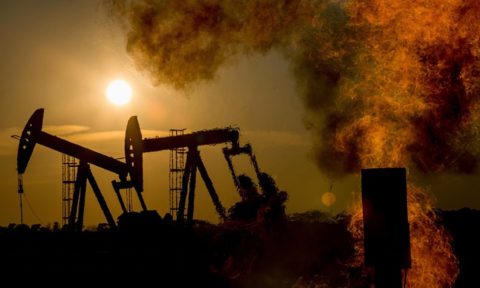Podcast: Play in new window | Download
Subscribe: RSS
 A funny thing happened while we were watching the bright shiny objects being juggled for our entertainment by the contestants in the bewitching midterm elections: the U.S. oil industry went code blue.
A funny thing happened while we were watching the bright shiny objects being juggled for our entertainment by the contestants in the bewitching midterm elections: the U.S. oil industry went code blue.
Okay, maybe that’s overdramatizing a bit, but the emerging reality is a serious threat to our well-being. It appears to more and more expert observers that America’s largest oilfield — the Permian Basin in the Southwest — has peaked. U.S. drilling and fracking activity has flatlined since June, and the rig count in the Permian has fallen to its lowest number in four months. The Energy Information Administration has cut its forecast of next year’s increase in oil production by 21%.
This comes at a time when the war in Ukraine has removed much of Russia’s oil output from international markets, when demand is recovering from its depressed state during the worst of the COVID pandemic, and when various elements of the supply chains are having trouble getting product and industry supplies where they are needed when they are needed. OPEC and Saudi Arabia have refused — or are incapable — of increasing oil production, in fact they have cut production in an attempt to jack up prices, which have fallen back to $85 a barrel from their high of $120 a barrel in June.
None of these factors has yet had its full impact on the market or on retail prices. It would seem inevitable that steeply rising fuel prices are in our immediate future. So this is no time for the Great American Oil Revolution to fizzle.
Serious and objective students of the U.S. oil industry have been predicting the fizzle for a long time. So long that they have earned a good deal of contempt for being wrong — so far. I like to point out that the fact that the predicted Big Earthquake on the San Andreas fault has not happened for a long time in ino way reduces the certainty that it will happen, and soon — in geologic time. The fact that we haven’t quite run out of oil yet does not mean that we aren’t going to.
Publications such as Forbes, the Wall Street Journal, the New York Times and The Guardian have joined specialty publications such as Oilprice.com in all but declaring peak oil to have arrived in the U.S. patch. But as far as I know none of them (except one NYT newsletter) has told the truth about the history of the fracking revolution in this country, and not one has stated the obvious reason why this had to happen.
(Can we just be clear about what fracking is? It’s wringing oil out of oil soaked rock, It uses hideous amounts of water, sand and toxic chemicals. It’s hard and expensive to do. The only reason you do it is that you can’t find any more liquid oil. It’s a desperate last stand.)
And the truth is that virtually no company involved in fracking since it took off in 2010 has made any money — when all the accounting is done. Between 2010 and 2020, the industry as a whole lost $300 billion dollars. The industry’s leading company, Chesapeake Energy, has never reported positive cash flow and has lost roughly $3 billion a year.
And the reason it was always going to be this way is the fact that a typical fracking well — which is far more expensive and difficult to build and operate than a legacy well — has an average productive life of three years, compared to the legacy well’s average of 20 years. To stay in business, a company has to start building a second well the very minute the first goes into production. And while well #1 might well show a profit, when you account for the capital investment required immediately by the second well, the company is hemorrhaging money.
But the mirage of a fabulously successful oil “revolution” and fake “energy independence” was kept pumped up by industrialists desperately in need of investors’ and bankers’ cash to keep going. It was, and remains, an enormous Ponzi scheme.
The alarms flaring now in the financial journals may not be the end of the story. A great deal of money is still at stake and they may find a way to keep the zombie walking for a while. But not for long.
As well as all the products you mentioned the other thing required to get those wells built was near zero interest. That well too has run dry. There were profits made though; by those brokering the junk bonds.
“OPEC and Saudi Arabia have refused – or are incapable – of increasing oil production…”
If I remember correctly, it was Matthew Simmons who stressed the “or are incapable” part of the Peak Oil equation in his book, Twilight in the Desert, some two decades ago. He didn’t live to see his prediction play out, but I believe it is now becoming a reality.
After all, petroleum is like real estate; there ain’t but so much of it.
Story out today says OPEC countries have failed to meet THEIR TARGETS for production in October. Their “planned” reductions weren’t supposed to kick in until November.
I like the earthquake analogy, and the signs have been there for those that care to look. To be entirely accurate though, the forecast for increase in production has been reduced by 21%.
Correct. I made the fix.